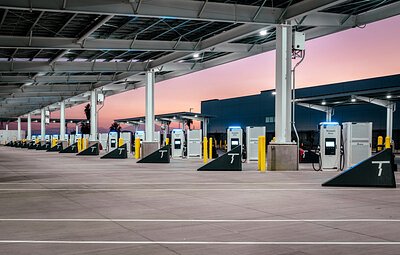
Terawatt's New Hub Powers Up California's Electric Freight Future
A new charging depot in Rialto, CA, signals a major step forward for zero-emission trucking, backed by billions in investment and a push for sustainable energy. Can California's infrastructure keep pace?
Terawatt's New Hub Powers Up California's Electric Freight Future
Rialto, CA – A new, large-scale electric vehicle charging depot has opened in Rialto, California, marking a significant milestone in the state’s ambitious transition to zero-emission freight transportation. Developed by Terawatt Infrastructure, the hub isn't just a charging station; it’s a strategic investment in the future of logistics, backed by substantial funding and a commitment to sustainable energy.
Terawatt’s Rialto facility is part of a larger initiative to create an “electric lane” connecting the Ports of Long Beach and Los Angeles – two of the nation’s busiest container ports – with key logistics hubs in the Inland Empire. This region, already home to the largest concentration of warehouses and distribution centers in the US, is ground zero for the state's zero-emission trucking goals. “The need for charging infrastructure along this corridor is immense,” explains one industry analyst. “California’s regulations are pushing fleets towards electric vehicles, but they need reliable, high-capacity charging to make it happen.”
Billions Invested, Ambitious Goals
The project isn’t happening in a vacuum. California’s Advanced Clean Trucks (ACT) and Advanced Clean Fleets (ACF) regulations mandate an increasing percentage of electric truck sales and purchases, with the ultimate goal of eliminating diesel trucks by 2045. To support this transition, the state is estimated to need over 82,000 charging ports for medium- and heavy-duty electric vehicles by 2032. This ambitious target requires massive investment, and companies like Terawatt are stepping up to meet the challenge.
The company’s approach goes beyond simply installing chargers. Terawatt has secured over $1 billion in funding, positioning it as a key player in the emerging EV infrastructure market. “They’re not just building charging stations; they’re building a network,” notes a logistics consultant. “Their strategy focuses on strategically located hubs with high-capacity charging, reliable power, and a commitment to sustainability.”
Powering the Future with Renewable Energy
A key differentiator for Terawatt is its commitment to renewable energy. The Rialto facility is powered by 100% renewable energy, primarily through on-site solar canopies. “Integrating renewable energy is crucial for truly sustainable transportation,” says a renewable energy expert. “It’s not enough to just switch to electric vehicles; we need to ensure that the electricity powering those vehicles comes from clean sources.”
Terawatt’s commitment extends beyond on-site generation. The company is also exploring options for on-site energy storage and robust grid interconnections to ensure a reliable and resilient power supply. This holistic approach is vital for accommodating the significant power demands of large-scale EV charging depots.
Meeting the Demand on the I-10 Corridor
The I-10 corridor, connecting the ports of Los Angeles and Long Beach to the Inland Empire and beyond, is one of the busiest freight corridors in the nation. The demand for EV charging along this route is particularly acute. According to recent data, a significant portion of truck trips on the I-10 are within the practical range of current electric trucks. This makes the region an ideal location for deploying EV charging infrastructure.
“We’re seeing a growing number of fleets interested in electrifying their operations along the I-10,” reports a fleet manager. “But they need reliable, high-capacity charging to make it work. Terawatt’s new hub is a step in the right direction.”
Challenges and Competition
The transition to electric freight isn’t without its challenges. The cost of electric trucks remains higher than diesel-powered vehicles, and the availability of charging infrastructure is still limited. Competition in the EV charging market is also intensifying.
Companies like Greenlane, WattEV, and Prologis Mobility are all vying for a piece of the action, investing in charging infrastructure and developing innovative solutions. “The market is becoming increasingly crowded,” observes a transportation analyst. “Companies that can offer reliable, affordable, and sustainable charging solutions will be the ones that succeed.”
WattEV is building out a network of depots with both high-speed charging and Megawatt Charging System (MCS) capabilities for next-generation trucks. Greenlane is developing a corridor between Southern California and Phoenix. These competing ventures illustrate the scale of investment and innovation required to meet the growing demand for EV charging.
Looking Ahead
Terawatt’s new hub in Rialto represents a significant investment in California’s electric freight future. The facility isn’t just a charging station; it’s a strategic asset that will help accelerate the transition to zero-emission transportation. However, sustained investment, ongoing innovation, and collaboration between public and private sectors will be essential to overcome the remaining challenges and realize the full potential of electric freight.
“This is a marathon, not a sprint,” cautions a sustainability consultant. “We need to continue investing in infrastructure, developing new technologies, and creating a supportive policy environment to ensure that electric freight becomes the norm, not the exception.” The success of projects like Terawatt’s Rialto hub will depend not only on the availability of charging infrastructure but also on a wider ecosystem of support – including government incentives, workforce training, and a commitment to sustainability throughout the supply chain. As California continues to lead the way in the transition to electric freight, the lessons learned from projects like this will be invaluable for other states and countries looking to follow suit.
📝 This article is still being updated
Are you a relevant expert who could contribute your opinion or insights to this article? We'd love to hear from you. We will give you full credit for your contribution.
Contribute Your Expertise →